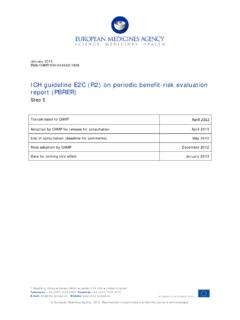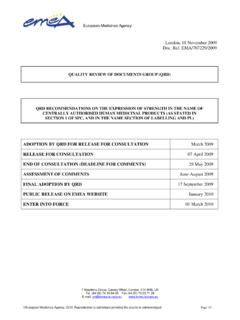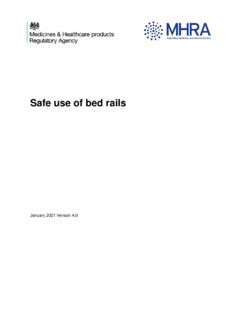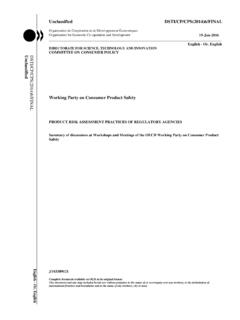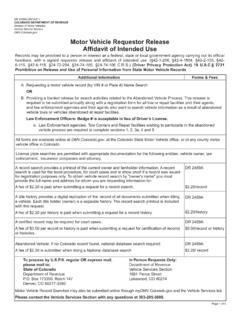Transcription of VOLUME 2C Regulatory Guidelines GUIDELINE ON THE ...
1 1 EUROPEAN COMMISSION HEALTH AND FOOD SAFETY DIRECTORATE-GENERAL Health systems and products Medicinal products NOTICE TO APPLICANTS Revision 4 VOLUME 2C Regulatory Guidelines GUIDELINE ON THE CATEGORISATION OF extension APPLICATIONS (EA) versus VARIATIONS APPLICATIONS (V) July 2019 This GUIDELINE will be included in The Rules governing Medicinal Products in the European Union The Notice to Applicants - VOLUME 2C Regulatory Guidelines 2 Revision 4 July 2019 GUIDELINE ON THE CATEGORISATION OF extension APPLICATIONS (EA) versus VARIATIONS APPLICATIONS (V) Medicinal products for human and veterinary use Introduction Commission Regulation (EC) No 1234/2008 as amended by Commission Regulation (EU) No 712/2012 concerning the examination of variations to the terms of marketing authorisations for medicinal products for human use and veterinary medicinal products defines the scope of what can be considered a variation to the terms of a marketing authorisation within the meaning of Article 1(26a), 23b of Directive 2001/83/EC relating to medicinal products for human use and Article 39 of Directive 2001/82/EC relating to veterinary medicinal products1.
2 The corresponding provisions in Regulation (EC) No 726/2004 are found in Articles 5 and 16a for medicinal products for human use and in Articles 30 and 392 for veterinary medicinal products, respectively. Article 2(4) of Commission Regulation (EC) No 1234/2008, states that an extension of marketing authorisation means a variation which is listed in Annex I and fulfils the conditions laid down therein. Annex I lists three main categories: 1. Changes to the active substance(s) 2. Changes to strength, pharmaceutical form and route of administration 3. Other changes specific to veterinary medicinal products to be administered to food-producing animals; change or addition of target species.
3 For the changes listed in Annex I any application will follow the same procedure as for the granting of the initial marketing authorisation to which it relates. The extension can either be granted as a new marketing authorisation or will be included in the initial marketing authorisation to which it relates. A typical extension application that could be included is Annex I 1(d) modification of the vector used to produce the antigen or the source material, including a new master cell bank from a different source, where the efficacy/safety characteristics are not significantly different. Exceptions that are not extension applications even though there is a change in active substance are: changes to the active substance of a seasonal, pre-pandemic or pandemic vaccine against human influenza, replacement or addition of a serotype, strain, antigen or combination of serotypes, strains or antigens for a veterinary vaccine against avian influenza, foot-and-mouth disease or bluetongue, replacement of a strain for a veterinary vaccine against equine influenza.
4 Although they concern a change in the active substance only a Type II variation is necessary. As experience has shown problems in the classification of extension applications (covered by Annex I) versus variations particularly regarding the items pharmaceutical form and strength, it is necessary to establish a common understanding of these terms. Based on the European Pharmacopoeia document STANDARD TERMS Introduction and Guidance for Use 3 this GUIDELINE proposes a harmonised and agreed interpretation of the above mentioned terms, with the aim of facilitating the application of the Regulation on variations throughout the EU. 1 The new Regulation (EU) 2019/6 on veterinary medicinal products will apply from 28 January 2022 and it will repeal Directive 2001/82/EC.
5 2 Until these provisions will be repealed by the Regulation (EU) 2019/6. 3 3 This GUIDELINE relates only to the procedure regarding the application of the Commission Regulation (EC) No 1234/2008 on variations and does not automatically affect other Regulatory decisions, such as the granting of a marketing authorisation or modification of an existing marketing authorisation, policies of competent authorities regarding the system of issuing authorisation numbers (sub-numbers) or on the fees calculation, changes to the name of a medicinal product or to the product information. In particular, the definition of strength in this GUIDELINE has no implication for the strength which is included in the name of the medicinal product in the SmPC, labelling and package leaflet.
6 The appropriate expression of the strength depends on the medicinal product concerned and must allow a correct use of the medicinal product . The product information ( name , SmPC, labelling and package leaflet) must carry the adequate expression of the strength. It is however at the discretion of each competent authority to apply (parts of) the definitions below to other Regulatory decisions, where appropriate ( fees). A) Definitions and principles 1) Pharmaceutical form According to the European Pharmacopoeia document STANDARD TERMS Introduction and Guidance for use , the terms dosage form and pharmaceutical form are defined as follows: Dosage form Pharmaceutical dose form. (Note: Dosage form and Pharmaceutical dose form are synonymous.
7 Pharmaceutical dose form Physical manifestation or a product that contains the active ingredient(s) and/or inactive ingredient(s) that are intended to be delivered to the patient. (Note 1: Pharmaceutical dose form and Dosage form are synonyms. Note 2: Pharmaceutical dose form can refer to the administrable dose form or the manufactured dose form, depending on the product that it is describing ). Pharmaceutical form A pharmaceutical dose form, a combined pharmaceutical dose form or a combined term. (Note: In the assessment of marketing authorisations applications in Europe, pharmaceutical forms that only differ with respect to the container/administration device may not always be considered as different pharmaceutical forms).
8 A pharmaceutical dose form is used to describe the manufactured product ( the item as presented in the packaging by the manufacturer) or the pharmaceutical product ( the item as intended to be administered to the patient, after any necessary transformation has been carried out). When used to describe the manufactured item, it may be referred to as the manufactured dose form; when describing the pharmaceutical product , it may be referred to as the administrable dose form. The Standard Terms database4 does not explicitly distinguish between manufactured dose forms and administrable dose forms. However, for a term representing a manufactured dose form such as Powder for solution for injection , the words for solution for injection indicate that a reconstitution is required, and that the resulting administrable dose form is Solution for injection.
9 According to / xii of the European Pharmacopoeia document STANDARD TERMS Introduction of standard terms of the European Directorate for the Quality of Medicines and Healthcare (EDQM), combined terms are sometimes necessary where a special container, closure or administration device is required for the correct administration of the medicinal product ; the closure or administration device may be an integral part of the immediate container. This applies for example to pre-filled syringes, pre-filled pens, pressurised preparations for inhalation and single-dose eye preparations . Therefore, these specific containers are generally regarded as different pharmaceutical forms and a change, a replacement or an 4 Available at 4 addition of such a container would result in an extension application of the marketing authorisation5.
10 A change or addition of a pharmaceutical form results in an extension application except in case of a deletion of the solvent, which results in a variation. A deletion of a pharmaceutical form results in a variation. However, in cases where a given pharmaceutical form has received a marketing authorisation which is separate to the marketing authorisation for other pharmaceutical forms or strengths, the deletion of the former will not be a variation but the withdrawal of the marketing authorisation. 2) Strength The quantitative composition in terms of active substance represents the strength. The concept of strength and the concept of concentration are inherently linked. The strength represents the amount of active substance in the pharmaceutical form, which can be defined per unit dose or as a concentration.










